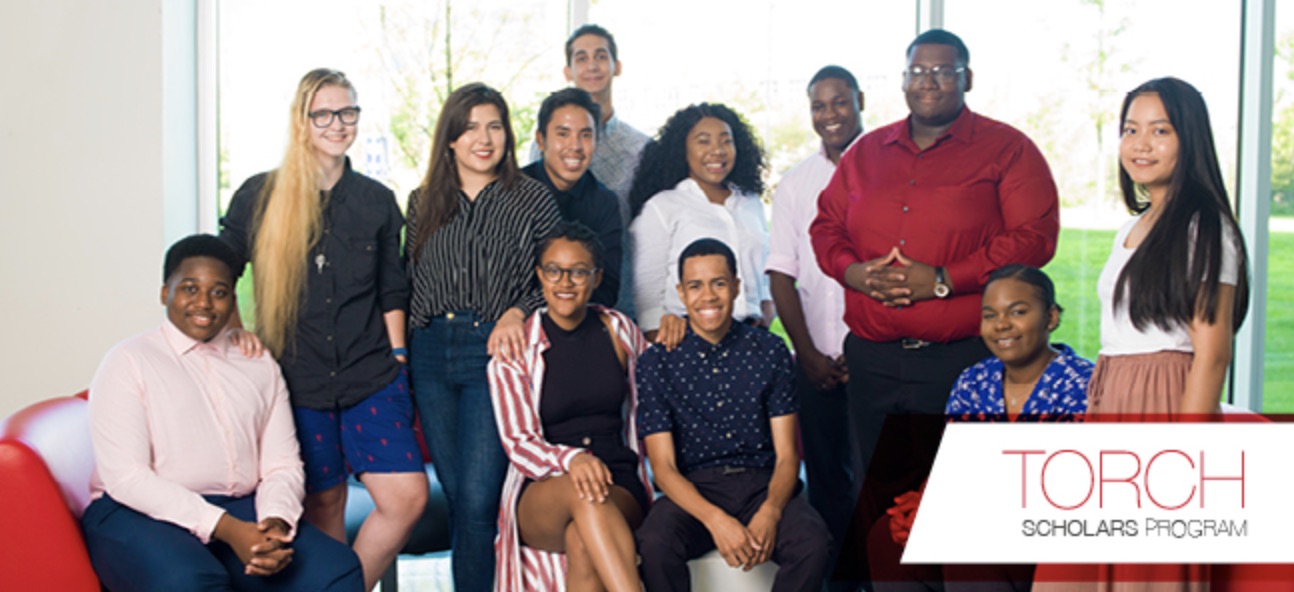Our Programs and Curriculum
Our Curriculum
Our online curriculum and virtual meetings allow us to bring together students from different schools, communities, and backgrounds. Our monthly large group sessions are further supported by small group discussions with the curriculum in each strand providing a context for the small group discussions. Students work through the online curriculum at their own pace, complete the assigned reading to enhance their understanding, and are provided with videos and examples to meet their learning style needs. Lessons are designed around the “Essential Questions,” developed by the Coalition of Essential Schools (Coalition of Essential Schools).
Participating students:
- Become more intentional in their academic studies
- Engage in the ongoing process of setting and reevaluating their goals
- Develop a deeper understanding of who they are across such areas as personality, temperament, mindset, gifts and talents, and grit
- Become invested in their own career and college outcomes
- Become intentional in their pursuit of leadership and community service opportunities
Time Commitment & Options
Our program runs from June 1 through May 1 (Enrollment Decision Deadline for college-bound students). Students have 24/7 access to our online curriculum so that participation in our program does not interfere with other activities or travel plans. Each month, students work at their own pace through an online learning module. On the first Saturday of each month from 10:00 am – Noon, we host a virtual meeting with students from throughout the country to discuss student learning and to further deepen student understanding.
Strand #1 – College/Career Planning (Grades 9 – 12): College/career planning is a knowledge- and labor-intensive process. First generation and public school students are at a huge disadvantage in developing strategies to plan their way into the right colleges and scholarships, and avoid student loan debt. The illustration below reflects the “average student loan debt by degree type.” (Source: Consumer Affairs) However, first generation students and students from lower income families leave college with student and Parent PLUS loan debt much higher than the average.

Consequently, our college/career planning process is designed to guide any student, from any background, in avoiding student loan debt. By expanding students’ and parents’ understanding of the college and financial aid processes, and developing strategies for expanding each student’s college and scholarship opportunities, we have achieved amazing results as supported by the testimonials of students featured throughout our website and reflected in our curriculum.
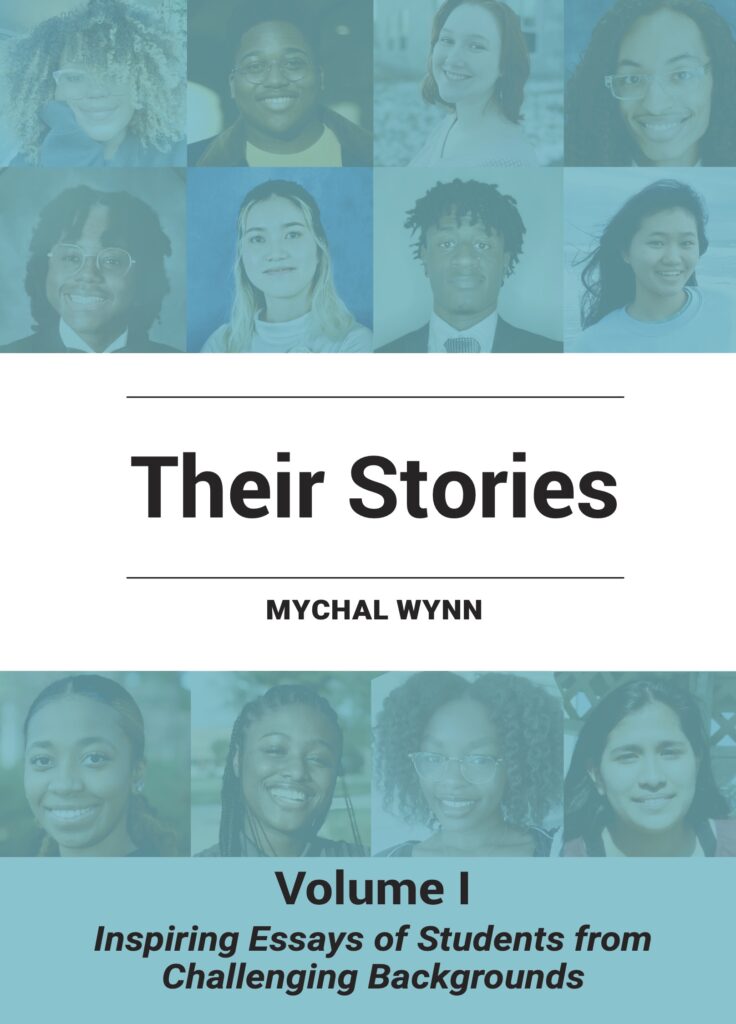 Strand #2 – College/Scholarship Essay Writing: A curriculum-based program developed by Certified College Admissions Counselor, Mychal-David Wynn, who holds a BA in English from Amherst College with a concentration in poetry, teaches students how to increase their writing skills for developing well-written college and scholarship essays. Students not only expand their understanding of the writing process, how to properly cite sources, how to adhere to the APA or MLA format, how to increase their vocabulary, and the importance of argumentative and persuasive essays in college admissions, but learn how to write strategically in a manner that makes strong connections between the Common Application essay and supplemental essays. Students receive feedback through the monthly discussions as part of a yearlong process of developing and increasing writing skills in preparation for college-level writing.
Strand #2 – College/Scholarship Essay Writing: A curriculum-based program developed by Certified College Admissions Counselor, Mychal-David Wynn, who holds a BA in English from Amherst College with a concentration in poetry, teaches students how to increase their writing skills for developing well-written college and scholarship essays. Students not only expand their understanding of the writing process, how to properly cite sources, how to adhere to the APA or MLA format, how to increase their vocabulary, and the importance of argumentative and persuasive essays in college admissions, but learn how to write strategically in a manner that makes strong connections between the Common Application essay and supplemental essays. Students receive feedback through the monthly discussions as part of a yearlong process of developing and increasing writing skills in preparation for college-level writing.
Students are guided in selecting a Common Application prompt, the process of breaking down and responding to multi-prompt supplemental essays, and the importance of incorporating non-cognitive variables into students’ essays.
Note: One-on-one advising and individual editing and review must be purchased separately.
 Strand #3 – College Planning for Athletes: While this program draws on many of the curriculum components of our College/Career Planning program, it is designed specifically for athletes with a primary career pathway focus. The curriculum guides student-athletes in developing a game plan to leverage their athletic participation into expanding their career, college, and scholarship pathways. Whether student-athletes have aspirations of playing their sport in college or being drafted by a professional sports team, our comprehensive curriculum guides student-athletes along pathways into the workplace, military, 2-year colleges, or 4-year colleges. While recruited athletes can benefit from expanding their college and scholarship opportunities, only 7 percent of high school student-athletes are recruited. Consequently, 93 percent of high school student-athletes need to plan for life beyond sports.
Strand #3 – College Planning for Athletes: While this program draws on many of the curriculum components of our College/Career Planning program, it is designed specifically for athletes with a primary career pathway focus. The curriculum guides student-athletes in developing a game plan to leverage their athletic participation into expanding their career, college, and scholarship pathways. Whether student-athletes have aspirations of playing their sport in college or being drafted by a professional sports team, our comprehensive curriculum guides student-athletes along pathways into the workplace, military, 2-year colleges, or 4-year colleges. While recruited athletes can benefit from expanding their college and scholarship opportunities, only 7 percent of high school student-athletes are recruited. Consequently, 93 percent of high school student-athletes need to plan for life beyond sports.
Note: We also offer a parent, teacher, counselor, coach, and mentor component in each of our strands for those interested in better supporting students.
 Strand #4 – Study Skills and Learning Strategies (grades 6 – 12): Whether a student is making the transition from elementary school into middle school or middle school into high school, or is a high school junior preparing to take the ACT, study skills and learning strategies are essential to student success. This curriculum-based program teaches students how to study and how to learn based on brain-based study skills and learning strategies research. Students learn how to set up at-home study locations, before and after class strategies, note-taking techniques, how to identify their time-of-day energy levels, and how to develop an approach to studying and learning based on their learning style, personality, temperament, and mindset. The curriculum also provides links to videos of college professors further expanding how the brain learns.
Strand #4 – Study Skills and Learning Strategies (grades 6 – 12): Whether a student is making the transition from elementary school into middle school or middle school into high school, or is a high school junior preparing to take the ACT, study skills and learning strategies are essential to student success. This curriculum-based program teaches students how to study and how to learn based on brain-based study skills and learning strategies research. Students learn how to set up at-home study locations, before and after class strategies, note-taking techniques, how to identify their time-of-day energy levels, and how to develop an approach to studying and learning based on their learning style, personality, temperament, and mindset. The curriculum also provides links to videos of college professors further expanding how the brain learns.
Our Instructional Approach
Our instructional approach is based on the Understanding By Design Framework, pioneered by professors Jay McTighe and Grant Wiggins. The Understanding by Design® framework (UbD™ framework) offers a planning process and structure to guide curriculum, assessment, and instruction. Its two key ideas are contained in the title: 1) focus on teaching and assessing for understanding and learning transfer, and 2) design curriculum “backward” from those ends.
Culturally Responsive Teaching: Also called culturally relevant teaching, is a pedagogy that recognizes the importance of including students’ cultural references in all aspects of learning. Traditional teaching strategies emphasize the teacher-student dynamic: The teacher is the expert and adheres strictly to the curriculum that supports standardized tests, while the student receives the knowledge. Research has proven that this teaching method is outdated. Our curriculum teaches students through the stories of other students from similar socioeconomic and sociocultural backgrounds. Consequently, students are not bound by artificial boundaries or limited aspirations based on family or community experiences. Through the curriculum units, students learn about students from similar backgrounds who have been offered admission to selective colleges and universities, who are pursuing graduate and medical school pathways, who have attended both HBCUs and PWIs, and who have been selected for such highly competitive programs as MIT MITES, Yale Young Global Scholars, Ron Brown, Gates, and QuestBridge.
 Body of Work: A concept through which students learn to engage in self-monitoring from grade to grade across the 3 pillars of scholarship, leadership, and service to become competitive college and scholarship applicants.
Body of Work: A concept through which students learn to engage in self-monitoring from grade to grade across the 3 pillars of scholarship, leadership, and service to become competitive college and scholarship applicants.
Backwards Mapping: A concept through which students learn how to begin with their long-term career or educational aspirations and work backwards to plan their trajectory forward.
Financial Aid Policies: A financial aid approach to backwards mapping through which students begin with the projected family income and work backwards to identify the best matches to need- and/or merit-based scholarship programs.
College Match: How a student’s body of work matches to individual colleges based on the college’s mission, vision, values, and institutional priorities.
Self-Presentation: How a student presents himself or herself when applying to college, for a scholarship, for an internship, or employment. A student’s self-presentation includes the student’s scholarship, leadership, and community service profiles; interview (when required); recommendations (when required); and essays in a manner that presents the student as a competitive applicant.
Scholarship • Leadership • Service
We now offer three distinct Cohort Programs. Our College Planning Cohort is offered both virtually and in-person to our school district partners. Our HBCU Cohort is a variation of our college planning cohort program that is HBCU-specific and offers both virtually and in-person sessions to our school district partners. Our Emerging Leaders Cohort is an all-virtual program offered to students in grades 9 – 11 (by application) from throughout the country.
College Planning Cohort (TM)
College Planning Cohort participation is available to any student in grades 9 – 12 attending school in our partner school districts. Students in grades 9 – 11 are guided through our 3 pillars of scholarship, leadership, and service in a manner consistent with expanding students’ college and scholarship opportunities.
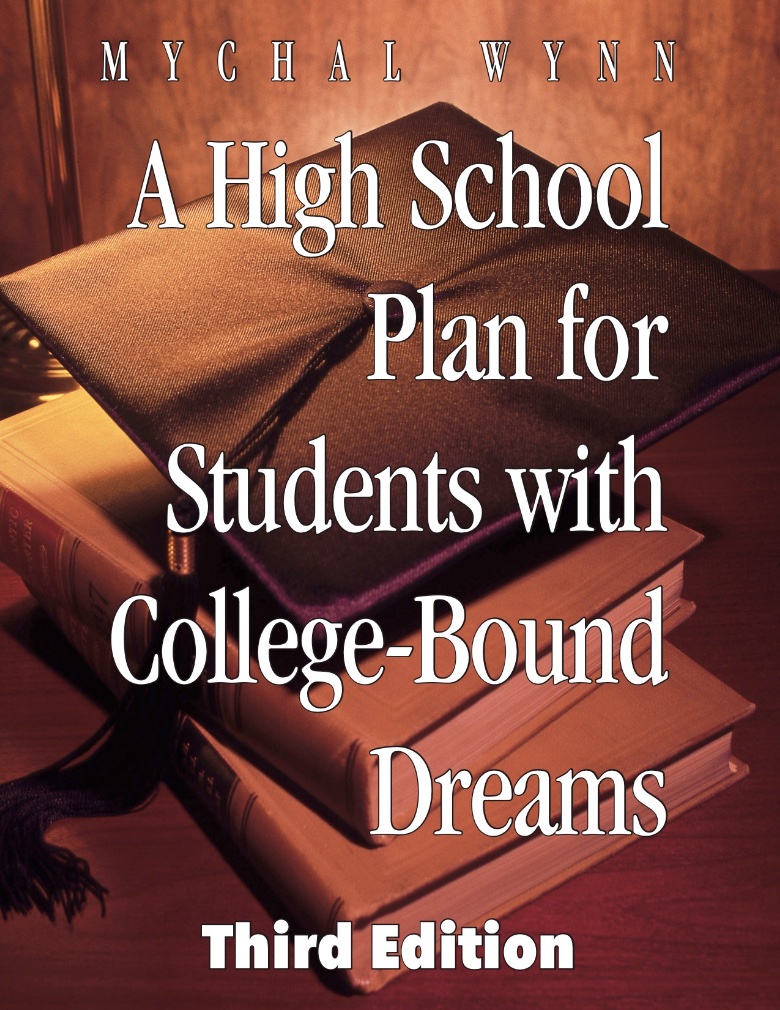 High school seniors receive comprehensive 1-on-1 guidance and wrap-around services, such as:
High school seniors receive comprehensive 1-on-1 guidance and wrap-around services, such as:
- Guiding students in selecting the Common Application prompt that will allow them to best tell their story and contextualize their college applications in a manner consistent with the selectivity of their colleges
- Developing, reviewing, editing, and proofreading college and scholarship essays
- Developing comprehensive college and scholarship lists to close financial aid gaps and minimize student and Parent PLUS loan debt
- Ensuring that senior-year course schedules meet the expectations of college admissions officers and scholarship providers
- Keeping students on track to meet college and scholarship deadlines
- Selecting admissions cycles to maximize college admissions and scholarship opportunities
- Selective college majors that are aligned with students’ “body of work”
- Teacher/Counselor guidance in writing recommendation letters
- Assisting students in matching to national and institutional scholarship programs
- Preparing students for college and scholarship interviews
- Assistance with completing the FAFSA
- Guidance in completing the Net Price Calculators to estimate college costs and student loan debt exposure
- Identifying college pathways aligned with students’ long term aspirations, i.e., career, graduate school, nursing school, medical school, dental school, pharmacy school, law school, etc.
- Developing résumés and transitioning high school résumés to college CVs
- Assistance with reviewing and appealing financial aid awards
- Assistance with reviewing college applications from the perspective of college admissions
- Supporting students throughout their undergraduate experience and recommending graduate school pathways
Curriculum:
- A High School Plan for Students with College-Bound Dreams: Third Edition
- A High School Plan for Students with College-Bound Dreams: Workbook
Responding to Inequity
 While any student attending school in our partner school districts may join our college planning cohort program, our program was developed by our founders, Mychal and Nina Wynn, to address the inequities in college admissions and student loan debt—both of which contribute to the wealth gap in America. In the article “American Wealth is Broken,” Maura Cheeks, daughter of Mr. Wynn’s DuSable High School classmate and retired professional basketball player, Maurice Cheeks, recounts an all too familiar story:
While any student attending school in our partner school districts may join our college planning cohort program, our program was developed by our founders, Mychal and Nina Wynn, to address the inequities in college admissions and student loan debt—both of which contribute to the wealth gap in America. In the article “American Wealth is Broken,” Maura Cheeks, daughter of Mr. Wynn’s DuSable High School classmate and retired professional basketball player, Maurice Cheeks, recounts an all too familiar story:Maurice Cheeks grew up in Chicago’s Robert Taylor Homes, once the largest public-housing development in the country; it’s now gone—the last building was torn down in 2007. The development opened in 1962, housing up to 27,000 people despite being planned to hold less than half of that. By 1975, 92 percent of the families relied on government assistance. My grandmother was well known around the building she lived in. She used to belt out my dad’s and uncles’ names to get them to come inside as soon as the street lights turned on. Secretary of Housing and Urban Development Henry Cisneros once said, ‘ don’t know of another place in America where there are 15 shootings and five killings over a weekend.’ My dad’s general feeling was that you lived your life as best you could. ‘it was rough,’ my dad told me. ‘But we didn’t really think about it at the time.’
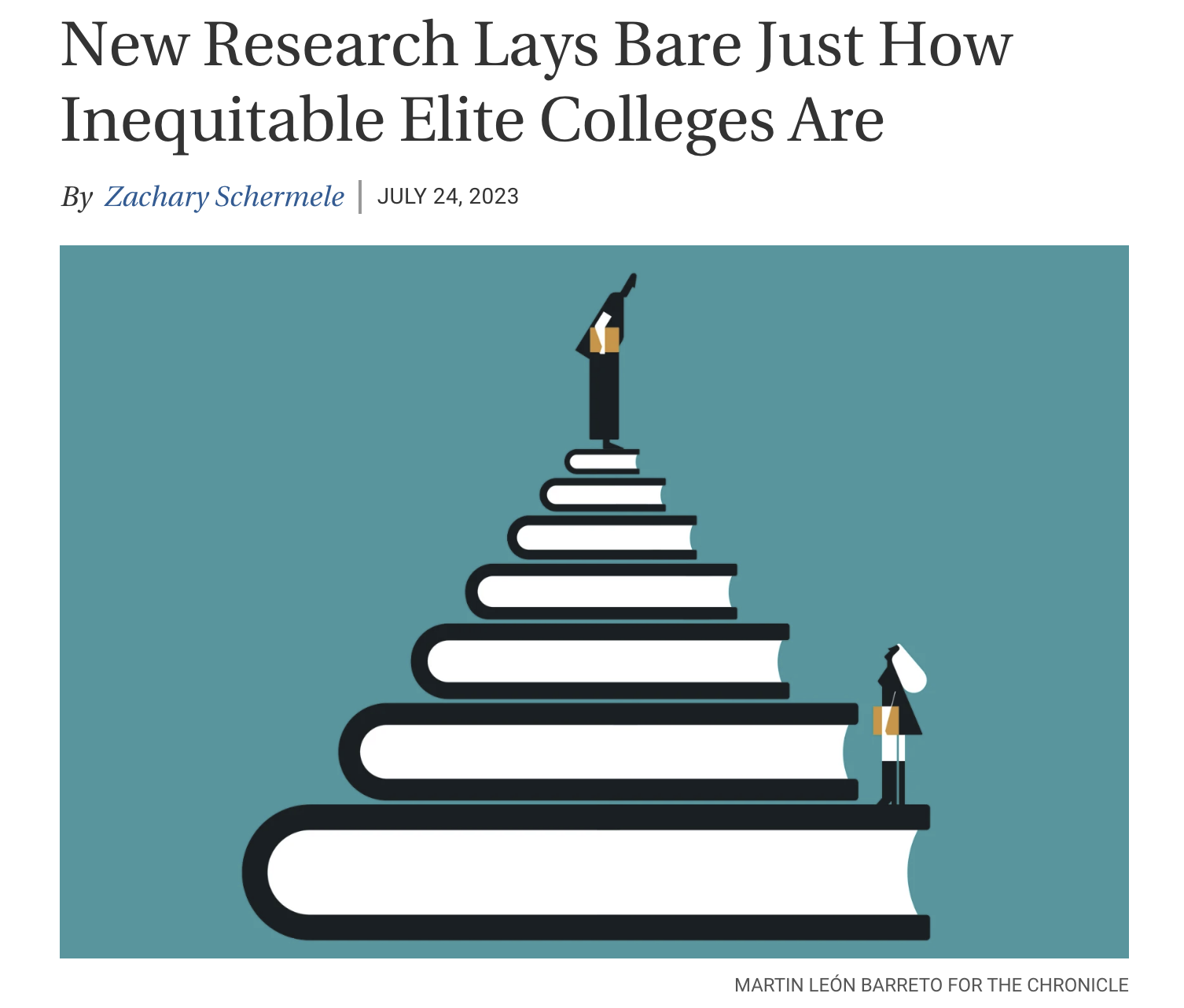
Though the nation’s most-selective private colleges have long been criticized for perpetuating inequality, a sweeping new study has reached a stark conclusion: They “amplify the persistence of privilege across generations.”
Research released Monday from three education scholars at Harvard and Brown Universities pulls from a trove of data, including federal tax returns, standardized-test scores, and application and admissions records, some of which were anonymously provided to the researchers by selective colleges.
The study looked at “Ivy-Plus” colleges, defined as the eight Ivy League colleges plus Stanford University, the Massachusetts Institute of Technology, Duke University, and the University of Chicago.
Their conclusion is decisive: getting into one of those colleges “dramatically changes children’s life trajectories.” Then, after those students graduate, they’re more likely to make more money than their peers who were educated elsewhere.
Our Program is One of a Kind
Note: Since recording this video, Kimberly is approaching the completion of a PhD in Math; Omar (creator of the video) is now attending Brown University and is a Jack Kent Cooke College Scholar; Josiah is a QuestBridge College Match Finalist and has been offered admission (together with full scholarships) to Boston College, Macalester College, Northeastern University, Washington & Lee University, and Williams College; and Jocelyne has been offered admission, together with a full scholarship, to Brown University. Other students from the youth leadership board: TaRetta is attending North Carolina A&T State University on a full scholarship; Jayla is attending Williams College on a full scholarship; Anna has been offered admission to the honors college at the University of South Florida; and Sydney has received a BS in Neuroscience from The University of Chicago is now applying to medical school.
7-year Curriculum
- From whose viewpoint are we seeing or reading or hearing? From what angle or perspective?
- How do we know when we know? What’s the evidence, and how reliable is it?
- How are things, events, or people connected to each other? What is the cause and what is the effect? How do they fit together?
- What’s new and what’s old? Have we run across this idea before?
- So what? Why does it matter? What does it all mean?
Through the process of deeply considering their current goals and long-term aspirations within a college planning context, students increase their critical thinking skills as they continuously ponder, “What is the right college for me? Where will I receive the most financial aid? How can I further develop my body of work?”
- 9th graders EXPLORE and ESTABLISH themselves for making a successful transition into high school through a yearlong focus on study skills and planning their high school trajectory across our 3 pillars of scholarship, leadership, and service.
- 10th graders REVISIT and RE-AFFIRM their successful approach to studying and learning and aligning scholarship pathways with their academics, leadership, service, and gifts and talents.
- 11th graders PLAN to pursue specific college and scholarship pathways.
- 12th graders IMPLEMENT THEIR PLANS in pursuing their affirmed college and scholarship pathways.
College Planning is All About Strategy
If increasing college readiness and expanding college access was all that was needed, student loan debt would not be so high and college completion rates so low. The table presented below, taken from the SallieMae report, “How America Pays for College 2018” provides insight into the $1.56 trillion student loan debt crisis and the disproportional load being carried by students from demographically identifiable subgroups.

College Readiness and Culturally Relevant
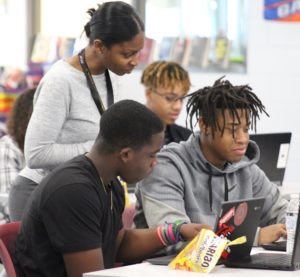 Our program meets the standards of the U.S. Department of Education ESSA, Title IV, Part A which focuses on increasing student achievement with access to a well-rounded education; increasing students’ technology proficiency and digital literacy; supporting college and career counseling; promoting access to accelerated learning opportunities such as AP, IB, and dual enrollment; promoting parent involvement; establishing community partners; innovative uses of technology; providing high quality digital learning opportunities; and delivering specialized curricula using technology. However, our program not only meets federal guidelines, but inspires. Our curriculum is culturally relevant in both content and student outcomes. Diverse student profiles are embedded in our curriculum so that students see themselves in the curriculum and are exposed to the college and scholarship pathways chosen by students from similar socioeconomic and cultural backgrounds. Students are exposed to postsecondary pathways into technical schools, community colleges, research universities, liberal arts colleges, military academies, HBCUs, High Hispanic Serving Institutions, and first generation-friendly institutions and support programs.
Our program meets the standards of the U.S. Department of Education ESSA, Title IV, Part A which focuses on increasing student achievement with access to a well-rounded education; increasing students’ technology proficiency and digital literacy; supporting college and career counseling; promoting access to accelerated learning opportunities such as AP, IB, and dual enrollment; promoting parent involvement; establishing community partners; innovative uses of technology; providing high quality digital learning opportunities; and delivering specialized curricula using technology. However, our program not only meets federal guidelines, but inspires. Our curriculum is culturally relevant in both content and student outcomes. Diverse student profiles are embedded in our curriculum so that students see themselves in the curriculum and are exposed to the college and scholarship pathways chosen by students from similar socioeconomic and cultural backgrounds. Students are exposed to postsecondary pathways into technical schools, community colleges, research universities, liberal arts colleges, military academies, HBCUs, High Hispanic Serving Institutions, and first generation-friendly institutions and support programs.
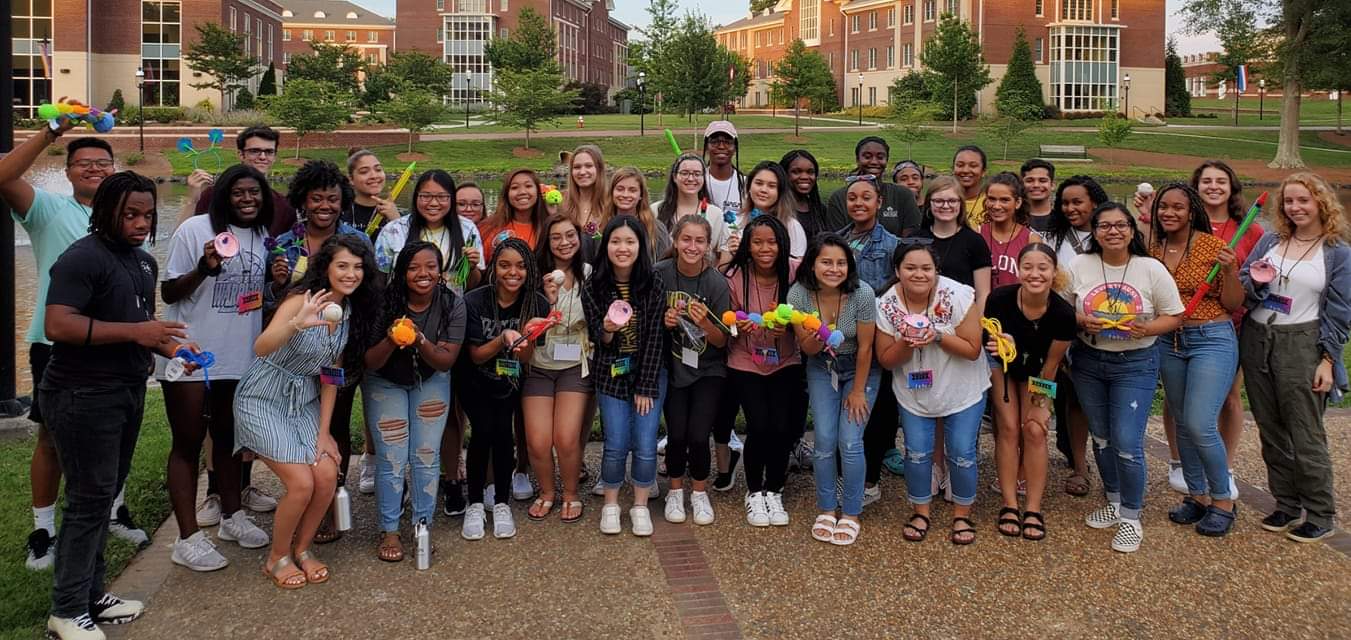
Our cohort students are choosing to be intentional in their college planning and are among the top performing and most motivated students in their respective schools; are measurably increasing their GPAs and SAT/ACT scores; are enrolling into the most rigorous classes; and are performing thousands of hours of community service and assuming leadership roles across an array of clubs, organizations, activities, and athletic teams.
 As a result of making informed college choices, our cohort students are assuming student loan debt at a far lower rate than the national average and graduating on time at a rate far higher than the national average. We are proud of the many hundreds of students with whom we have worked who are choosing to “Own the Process.”
As a result of making informed college choices, our cohort students are assuming student loan debt at a far lower rate than the national average and graduating on time at a rate far higher than the national average. We are proud of the many hundreds of students with whom we have worked who are choosing to “Own the Process.”
In 2019 Elon University Odyssey Scholar, Yuzu Do, from our Guilford County Schools Cohort was awarded 3 full scholarships and accepted the full scholarship to Elon University. Yuzu, a first generation immigrant from Vietnam, is pictured above (fifth from left in the front row) with other Odyssey Scholars.
In 2023, Yuzu went on to graduate from Elon University with two degrees—BS and MS in Accounting.
In 2018 Torch Scholar, Damian Lee from Florence County School District 3 Cohort (SC) (seated on the far left), was offered 3 full scholarships and accepted the full scholarship to Northeastern University.
In 2023, Damian received a BS in Political Science and Africana Studies from Northeastern, was selected as one the inaugural Northeastern University Senior Leadership Award recipients, and subsequently offered a full fellowship to graduate school at Northeastern.

The Differences Between College Planning, College Readiness, and College Awareness
Typically, school, mentoring, and community-based programs provide college readiness or expand college awareness through social skill development, study skill development, college tours, and conversations about college and careers. However, college planning is largely relegated to private college admissions counselors or advisors who work one-on-one with students or in small groups for fees ranging from a few hundred dollars to several thousand dollars. The Princeton Review “Ultimate Admissions Package” costs $2,799 and is targeted toward high school seniors who are ready to apply to college. Private College Advisors can easily cost $10,000 for a Common Application and essay review.
In the article, “How Much Would You Pay to Get Your Child into Harvard,” the $10,000 consultant fee was paid by a family to increase the odds of their child being offered admission to Amherst College—where our older son received his degree and where we have successfully assisted many cohort students in being offered admission. One of our Guilford County Schools Cohort students, Brenna Kaplan, posted a video sharing her journey, and our guidance, into Amherst College.
We are the only nonprofit community-based organization (CBO) with a comprehensive proprietary research-based and research-responsive curriculum providing college planning guidance freely to students and families in our partner school districts; at a deeply discounted price for students at our faith- and community-based partners, and at minimal price directly to students and families through our online program. In contrast to college readiness and college awareness, college planning involves course planning, summer planning, college/career research, self-assessment, leadership development, focusing community service activities, choosing the right extracurricular activities, social media assessment, navigating online portals, communicating with college admission and financial aid officers, completing the FAFSA and CSS Profiles, personality type profiles, multiple intelligences, narrative writing, institutional and private scholarship research, reviewing and negotiating financial aid award letters, and setting short- and long-term goals within a grade level specific and strategic context. Students and parents, particularly those who will be the first in their family to attend college, need assistance with navigating the FAFSA and CSS Profile, and communicating with college admission and financial aid officers. All of these areas are covered in our printed materials, throughout our online curriculum, and through one-on-one conversations with students and families.
Click here to download a brochure
Click here to download our Pinellas County Schools Program Outcomes
References
Burnham, K. (2024). 5 Culturally Responsive Teaching Strategies. Northeastern University. Retrieved 5/15/25, from https://graduate.northeastern.edu/knowledge-hub/culturally-responsive-teaching-strategies/
Student Loan Statistics 2025. (2024). Consumer Affairs. Journal of Consumer Research. Retrieved 4/16/25, from https://www.consumeraffairs.com/finance/student-loan-statistics.html
McTighe, J., Wiggins, G. (2012). Understanding By Design Framework. ASCD: Alexandria, VA.
